|
|
|
Acetaminophen (Tylenol) in overdose can seriously damage the liver. It should never be taken by people who use alcohol heavily; it can result in severe liver damage and even a condition requiring a liver transplant.
Everyone has one nostril that is larger than the other.
People with high total cholesterol have about two times the risk for heart disease as people with ideal levels.
Vital signs (blood pressure, temperature, pulse rate, respiration rate) should be taken before any drug administration. Patients should be informed not to use tobacco or caffeine at least 30 minutes before their appointment.
The Centers for Disease Control and Prevention (CDC) was originally known as the Communicable Disease Center, which was formed to fight malaria. It was originally headquartered in Atlanta, Georgia, since the Southern states faced the worst threat from malaria.
 This bike actually flies—thanks to six horizontal propellers and a battery-powered motor. Changing ...
This bike actually flies—thanks to six horizontal propellers and a battery-powered motor. Changing ...
 The schematic of a variable valve timing control circuit, showing that battery power (+) is being ...
The schematic of a variable valve timing control circuit, showing that battery power (+) is being ...





